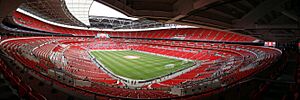National Stadium facts for kids
A national stadium is a special sports venue where a country's most important games are played. Think of it as the main stage for big events like football matches, athletic competitions, or even opening ceremonies for major international events. These stadiums are often the home ground for a country's national sports teams, like their national football or rugby team.
Having a national stadium is a big deal for a country. It shows off their pride in sports and provides a central place for fans to gather and cheer for their teams. These stadiums are usually very large, with lots of seats, and have modern facilities for both players and spectators.
Contents
What is a National Stadium?
A national stadium is a sports arena that is officially recognized as the primary venue for a country's national sports teams or major national events. It's not just any big stadium; it often holds a special place in the country's history and culture.
Why are National Stadiums Important?
National stadiums are important for several reasons:
- National Pride: They symbolize a country's passion for sports and its achievements on the world stage.
- Major Events: They host big international competitions, like World Cup qualifiers, Olympic Games ceremonies, or major athletic championships.
- Home Ground: They serve as the main home for national sports teams, giving them a consistent place to play.
- Economic Boost: Hosting large events at these stadiums can bring in tourists and money, helping the local economy.
- Cultural Hub: Beyond sports, they can also host concerts, festivals, and other large public gatherings.
Famous National Stadiums Around the World
Many countries have famous national stadiums that are known worldwide.
Wembley Stadium (England)
Wembley Stadium in London, England, is one of the most famous national stadiums. It's often called the "Home of English Football." The original Wembley Stadium, known for its twin towers, opened in 1923 and hosted many historic events, including the 1966 FIFA World Cup Final. The current Wembley Stadium was rebuilt and opened in 2007. It has a massive arch that can be seen from far away and can hold 90,000 spectators. It hosts major football matches, including the FA Cup Final, and also big concerts.
Maracanã Stadium (Brazil)
The Maracanã Stadium in Rio de Janeiro, Brazil, is another legendary national stadium. It was built for the 1950 FIFA World Cup and was once the largest stadium in the world by capacity. It has hosted two FIFA World Cup Finals (1950 and 2014) and the opening and closing ceremonies of the 2016 Summer Olympics. It's a place where Brazilian football history has been made many times.
Stade de France (France)
Located just north of Paris, the Stade de France is the national stadium of France. It was built for the 1998 FIFA World Cup, which France won. It's used for both football and rugby matches, as well as major athletic events and concerts. It has a unique design with a large, circular roof.
Other Notable National Stadiums
- Santiago Bernabéu Stadium (Spain): While primarily the home of Real Madrid, it often serves as a de facto national stadium for Spain's national football team.
- Olympic Stadium (Germany): The Olympiastadion in Berlin has a rich history, built for the 1936 Olympic Games, and has hosted major football events.
- National Stadium, Beijing (China): Also known as the "Bird's Nest," it was built for the 2008 Summer Olympics and is a stunning example of modern architecture.
Design and Features
National stadiums are designed to be impressive and functional. They often feature:
- Large Seating Capacity: To accommodate tens of thousands of fans.
- Modern Facilities: Including comfortable seating, VIP boxes, media centers, and changing rooms for athletes.
- Advanced Technology: Such as large video screens, sound systems, and sometimes retractable roofs.
- Accessibility: Designed to be easily accessible for all visitors, including those with disabilities.
- Multi-purpose Use: Many national stadiums are built to host different sports (like football and rugby) and non-sporting events.
These stadiums are more than just sports venues; they are landmarks that represent a country's sporting spirit and national identity.
See also
 In Spanish: Estadio nacional para niños
In Spanish: Estadio nacional para niños


